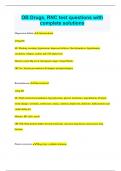OB Drugs, RNC test questions with complete solutions Magnesium Sulfate ✔✔Anticonvulsant 4/5mg IM SE: Flushing sweating, hypotension, depressed reflexes, flaccid paralysis, hypothermia, circulatory collapse, cardiac and CNS depression Monitor serum Mg levels (therapeutic range 3 -6mg/100mL) OB Use: Seizure pre vention in Eclampsia and preeclampsia Betamethasone ✔✔Glucocorticoid 12mg IM SE: Fluid retention/accumulation, hyperglycemia, glucose intolerance, hypokalemia, GI upset, mood changes, insomnia, restlessness, mania, catatonia, depression, delusions, halluc inations and violent behavior. Monitor: BP vitals, mood OB USE: Help preterm babies develop surfactant...decrease lung disease and increase lung function Pitocin (oxytocin) ✔✔Drug class: synthetic hormone Usual dose/route: IV standard concentration of 1 0 units to 1000ml, 20 units to 1000ml and 30 units in 500ml Admin through a second line connected to main line and always by pump. Begin dosage at 1 milliunit per minute and increase the rate by 1 -2 milliunits per minute no more frequently than every 30 -60 minutes based on progression of labor. Side effects: MATERNAL: uterine tachysystole (more than 5 contractions in 10 min or a series of single contractions lasting greater than or = to 2 min or contractions of normal duration occurring within 1 minute of each other), placental abruptions, uterine rupture, unnecessary c section due to abnormal FHR and patterns, postpartum hemorrhaging, and infection. FETAL: hypoxemia and acidosis eventually resulting in abnormal FHR and patterns. Use in obstetrics: primarily used for labor induction and augmentation, stimulate lactation, prevent hemorrhage post partum. Patient teaching: explain reasons for usage, effects Cytotec (Misoprostol) ✔✔Drug class: Prostaglandin E1 (PGE1) Usual dose/rout e: 100 or 200 mcg tablet which is prepared in pharmacy to ensure proper dosage. Initial dose is 25mcg inserted transvaginally into the posterior of the vaginal fornix using the tips of the index and middle fingers WITHOUT lubricant. Repeat every 3 -6 hours up to 6 doses in a 24 hour period or until and effective contraction pattern is established, the cervix ripens (Bishop score of 8 or more) or adverse reactions occur. Side effects: higer doses more likely to cause nausea vomiting, diarrhea, fever, uterin e tachysystole, with or withought an abnormal FHR and patterns or fetal passage of meconium. The risk for adverse reactions is reduced with lower doses at longer intervals between doses. Use in obstetrics: Used to ripen the cervix making it softer and causing it to begin to dilate and efface, stimulating contractions. Patient teaching: : explain procedure to patient and family. Void before insertion, must maintain a supine Methergine (Methylergonovine maleate) ✔✔Drug class: ADRENERGIC ANTAGONIST; ERGOT; OXYTOCIC Usual dose/route: 0.2 mg IM every 2 -4hours up to 5 doses may also be given intrauterine or orally. Side effects: hypertension, nausea, vomiting, headache. Use in obstetrics: contraction of the uterus. Patient teaching: Report severe cramping or ↑bleeding.Report cold or numb fingers/toes, n/v, chest/muscle pain. Rubella vaccine ✔✔Drug class: Vaccine Usual dose/route:I0.5 mL subcutaneously into the outer aspect of the upper arm. Side effects: Difficulty in breathing or swallowing, hives, itchi ng, especially of feet or hands, reddening of skin, especially around ears, swelling of eyes, face, or inside of nose, unusual tiredness or weakness (sudden and severe). Use in obstetrics: when rubella vaccine is given postpartum it is to prevent future pr oblems from congenital rubella syndrome for a fetus (first trimester). Patient teaching: You should not receive a booster vaccine if you had an allergic reaction after the first shot. Keep track of any and all side effects you have after receiving this vac cine. When you receive a booster dose, you will need to tell the doctor if the previous shots caused any side effects. Becoming infected with measles, mumps, or rubella is much more dangerous to your health than




